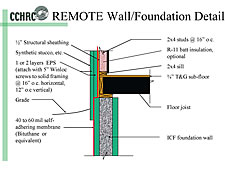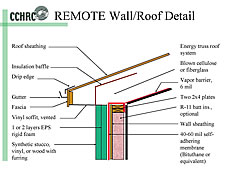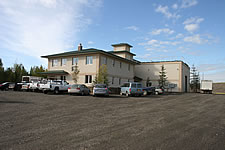Building as experiment
by Jeff Fay, Cooperative Extension Service

The Cold Climate Building and Infrastructure Research and Testing Facility was designed by members of the Cold Climate Housing Research Center.
![]()

Research Testing Facility Project Director Mike Musick and Rich
Seifert tour the building’s "green" roof. The clerestory windows
provide natural light to the north-facing laboratory below.
Cold Climate Housing Research Center President and CEO Jack Hébert is justifiably proud of his new office. The new CCHRC Cold Climate Building and Infrastructure Research and Testing Facility has taken shape over the last year and a half just to the east of the Thompson Drive entrance to the UAF Fairbanks campus.
CCHRC secured more than $5.2 million to construct the 15,000-square-foot building that houses offices, two laboratories for testing building materials and techniques, classrooms, a library, meeting rooms and demonstration space.
While the facility has laboratories for conducting experiments, the building itself is a showcase of, and a test bed for, innovative building technology for northern climates.
Starting from below ground and rising all the way to the roof, the CCHRC building is loaded with earth-friendly shelter technology.
- The building was designed to the standards of LEED--Leadership in Energy and Environmental Design Green Building Rating System, a voluntary, consensus-based national standard for developing high-performance, sustainable buildings.
- The building site is marginal for "normal" building techniques. There’s permafrost under the building, creating at least the possibility of some settling and ground movement over time. A year before construction began, a storm water retention pond was dug to the east of the building site. The soil excavated from the pond location was placed on the site of the future building to add mass and compact the soil to prepare it for the weight of the building.
- The building’s foundation can be raised to compensate for any ground movement because of the special footings at the base of the walls that allow the entire building to be jacked up with 50-ton jacks and leveled with an injection of grout or structural foam into the resulting void. Watch a video highlighting this aspect of the design.
- The wall systems in the building are examples of the Residential Exterior Membrane Outside Insulation Technique—a new approach to residential wall construction design that extends the life of a house by treating the wood elements of the wall structure as an internal component of the structure. Unlike a traditional wall, the vapor barrier is outside the structural components of the wall. Various insulation materials were used in different parts of the building to test their effectiveness. See detailed graphics highlighting this aspect of the design.
- The basement contains a wastewater treatment system that recycles gray water, tanks for rainwater catchments and delivered potable water. Gray water from the sewage treatment system will be recycled to flush toilets and water the grounds. Composted sewage sludge will provide fertilizer for the site.
- A sophisticated ventilation system incorporates indoor and outdoor air quality measurement with recirculation, filtration and heat recovery to maximize good air quality for occupants.
- The lighting systems use the highest efficiency fixtures and feature controls that sense ambient light levels as well as occupancy and adjust the light levels automatically.
- There are several heating systems in the building. On the ground floor, a 12,000-pound wood-fired masonry heater will provide gentle, long-lasting radiant heat. Three high-tech oil-fired boilers provide additional radiant heat via a network of tubing embedded in the floors. One of the boilers can be switched to run on waste cooking oil or other alternative fuels. In the future a co-generation plant will convert oil or wood to heat and electricity.
- Part of the building’s roof is flat and is designed to be an area to grow plants. These green areas provide a measure of evaporative cooling in summer and meter out water that falls on them instead of just shedding water and sending it down the downspouts as with a more traditional roof.
- More than six miles of Ethernet cables connect to more than 400 sensors and instrumentation installed both on the grounds and within the building, from the basement to the roof, to collect moisture and temperature data on the performance of various building materials as well as the structure’s effect on the site.
All photos by Jeff Fay, Extension Communications, unless otherwise noted.





